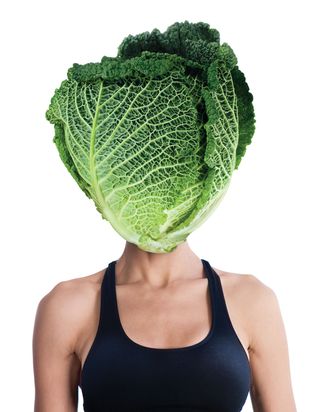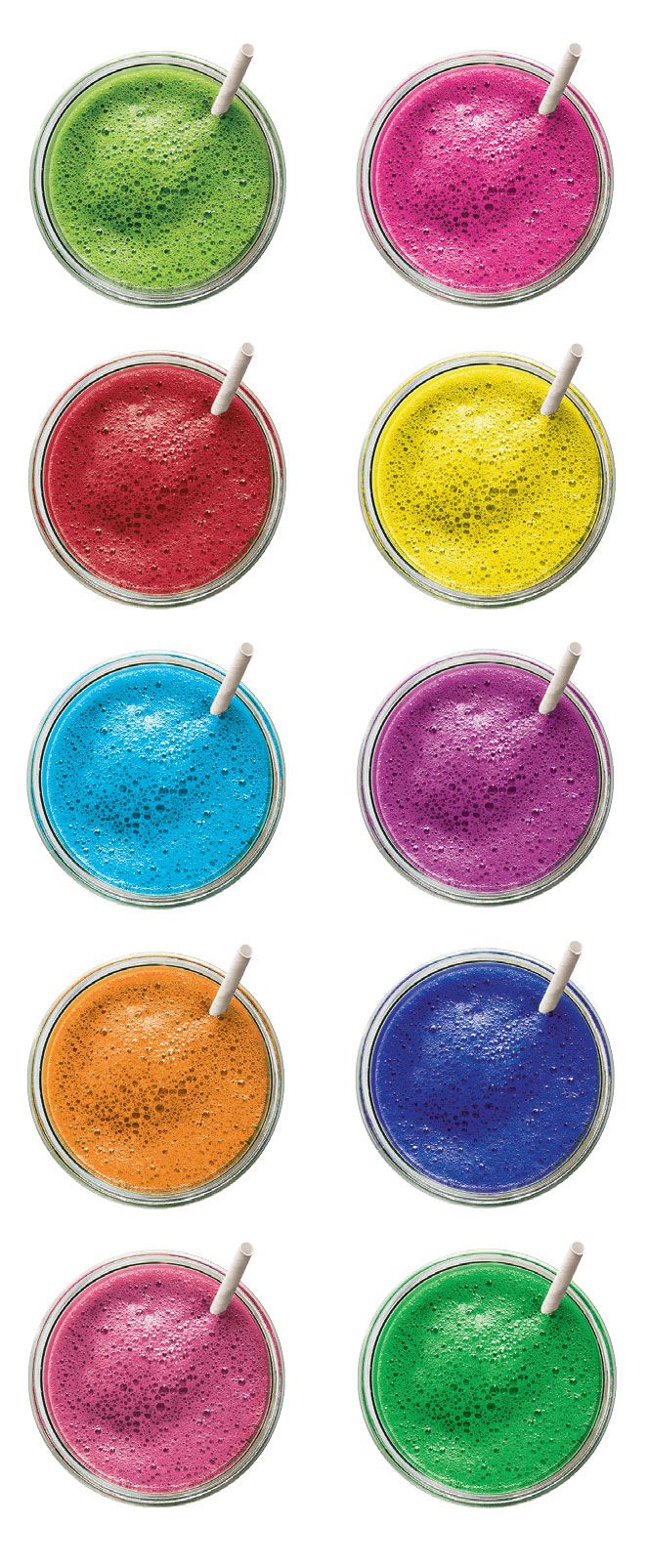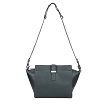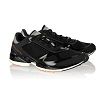
I’m sipping a Mean Greens juice—kale, cucumber, chard—at Irving Place’s One Lucky Duck with Allison, a 34-year-old executive for a cosmetics company. Meticulously dressed in a silk skirt and a bright-red blazer with the sleeves rolled up, Allison is on her third day of a “juice cleanse,” meaning she hasn’t consumed anything—other than, of course, juice—for almost 72 hours. She’s suffering, but also oddly buoyant. “I’ve been hangry all day—that’s a combination of hungry and angry,” she says, diamond studs sparkling under a sheet of blonde hair. “But tomorrow I’ll eat. I’ll have melon, and a kale-spinach salad. And this weekend I’ll go to Del Frisco’s for a martini and a steak.” She rubs her lips together a little bit, as if savoring dry vermouth. “Everything will taste so good,” she says. “I already know it.”
If you can make it through a juice cleanse, you can make it anywhere. New York, Los Angeles, San Francisco: They’re all fully in the grip of the miraculous, completely life-changing, wow-wow-wow power of juice, a new emblem of modern urban virtue, self-control, and simplicity. “Juice cleansing” is as much of a mantra today as “White bread is the devil, and sugar the neighbor of the beast,” which first issued forth from the inestimable Boy George, or Michael Pollan’s “Eat food. Not too much. Mostly plants.”
In a juice cleanse, you suffer, or get hangry, for style. Maybe you can’t go three days without food, like Allison. Maybe you can only skip a meal, for a liquid lunch of juice. You’ll still experience benefits, say the new juice tycoons. And more than that: You will, perhaps, meander down the road to transcendence.
“I’m not exaggerating when I say juice changed everything for me,” says Allison, swigging from a clear bottle shaped like a baby’s, its cloudy green murk far from what issues from a mother’s breast but meant to be as nourishing. A bit over a decade ago, she was a dentist’s daughter in a tiny town outside Detroit swearing allegiance to John Cougar Mellencamp. Now she’s conquering New York City. “I have so much energy,” she says, revealing a set of fabulous teeth. She adds, “I’m so motivated”; “I’m normally high-strung, but I feel high on life”; and “I drank nothing but juice this weekend, and I was up at 7 a.m. on Sunday and cleaned the whole apartment!”
Her face starts to glow. “On my last juice cleanse,” says Allison, “I took small sips of green juice” before working out, in the morning, at the barre-method studio chain Physique 57, and in the evening, before spinning classes at Flywheel, where students’ energy output is charted on a digital monitor. And there she was at the top of the list. “I got first place in Flywheel,” she crows, flashing those teeth. “Because of the juice!”
Here’s something about life in the big city that’s always required elixirs, tonics, various controlled and uncontrolled substances (espresso, cocaine, a shot in the butt) to sharpen you up, or kill the pain, or prepare you for urban combat. Juice, pulpy Eucharistic beverage of a modern cult, accomplishes this and more, getting its devotees jazzed up, under control, and certain they’re living right. And, of course, it hastens that other thing that’s so important to New Yorkers—exceptional, twiglike thinness. Of this you must not speak, though clearly it is the highest and most sacred goal of all. Soon, Allison is going to Bora Bora, and she’s been buying bathing suits online like crazy. “My bathing suits are falling off me,” she says. “Yessssssss!”
Juice is a treat and replaces the a-nutritious yet equally fetishized cupcake, a reward for tolerating urban difficulty. Juice announces that America is still a bountiful land of plenty despite our abuse of the Earth. Juice announces that you are hip to the trends, part of the scene that includes Gwyneth Paltrow, Salma Hayek, and other toned-and-together Celebrity Juice Fans featured in Star magazine. Juice says you don’t do manual labor: You make money with your fingers in the new economy, nails painted a cheery neon or pastel gel as you text. Juice gets attention on social media, which seems made for such announcements as “Loving my juice cleanse to help me get ready for a very important photo shoot!” And for a certain, uniquely American urban tribe, juice is a sacrament—or at least part of the sacrament.
I admit that I have been a part of this tribe, partaken of this beverage. The other day, I sold 25 dog-eared but awesome books (Don DeLillo, a Willie Nelson biography, some books about jazz that I never read) to the Strand bookstore for a grand total of $14 and then walked down Broadway for an elixir of apple, pear, and ginger, for which I paid $10. I guess it was a fair trade. Fresh juice is silly and sort of infantile and, yes, unless it contains only green vegetables, it tends to pack as much sugar as Odwalla. It appeals to those of us who aren’t possessed of great eating habits and with a lottery-ticket mentality about health. I know this. Still, I’ve been seduced.
Would you like a grapefruit-blue-green-algae juice? Or parsley-spinach-cucumber-carrot? What about a combination of apple, pear, pineapple, wheatgrass, and mint? Do these tastes even go together? At the juice bars—sorry, juice “boutiques”—pre-made juices are lined up in rows like little tubs of paint (they sometimes last for weeks, which seems like a long shelf life for a live food). The refrigerators carry an array of “solids,” as food is called in this world: grab-and-go nori rolls; quinoa bowls; and tiny tubs of açai blended with granola, almond milk, and banana. You fill Organic Avenue’s tiny, chic branded tote, turn over an astonishing amount of cash, and off you go—one-stop shopping for the food and nutrition and diet revolutions.
The juice philosophers intone that the drink works on both a physiological level, as its “living enzymes” increase one’s internal metabolism and allow the body to heal itself from sundry ailments, and a metaphysical one. There’s often a suggestion that the energy, the electric feeling that Allison and others speak of, may be actual electricity. “Your body has two brains: one in your head and one in your gut,” Alejandro Junger, a doctor with a cult following, writes in one of his books, Clean Gut. When you think, sparks of electricity appear in your head. When you experience a “gut feeling,” sparks of electricity flick on the neurons of this second brain. “While your first brain serves as your intellectual hardware, your second brain—the gut—is your spiritual and emotional GPS,” he writes. “Without it, you’re lost.”
Marcus Antebi, owner of the fifteen-store chain Juice Press and this world’s resident Mad Hatter, is at this juice vanguard (which, by the way, Barron’s has estimated as a $5 billion business, growing by at least 4 percent a year). Juice, Antebi maintains, is the “frontier of higher food consciousness,” and without it, “your vital forces are smothered by the consumption of garbage, including creativity and spiritual happiness.” Postcards and menus at Juice Press say things like “Your genes do not control your health and destiny—diet and lifestyle control how your genes will express themselves.” And “It’s time to wage war! With tomatoes not guns! War against the giant corporations that disguise poisons and processed foods as ‘indulgences’ or even as light and healthy choices. Wake up people! You’re being made sick by people who stand to profit from your complacency.” There’s more: “Achieving remarkable physical, emotional, and spiritual status is just a few raw salads and juices away.”
Also: “Assertive women who drink juice are fucking sexy” and “What makes penis happy? More green juice.”
On a recent afternoon, Antebi strides into a storefront he’s leased in Tribeca with a bunch of spray cans. His appearance does not disappoint: a sober-since-16 East Village lifer and Thai boxer, he has a tattoo of a black skull on his Adam’s apple, the eyes painted a demonic red, and a large gun inked on his underarm. He gets to work, putting lines on the floor for a contractor: one for the refrigerators for the juice, and one for the cash register for the juice.
“You eat something processed, or steak, you’re not eating something alive,” says Antebi, gesturing wildly. “It’s completely dead. It’s inanimate matter. Juice contains living things that your body feeds off and cooperates with. It enhances the electrical force in your own body.” He nods a little. “Now, a Ph.D. at Columbia University hears that and says I’m an idiot. They say I can’t prove it. Well, I don’t have to prove it. Ph.D.’s drink coffee, and they don’t drink juice.”
He starts drawing on the floor, moving fast like a graffiti artist—a black color, then a yellow, to mark a three-compartment sink. After a few minutes, he feels woozy. “I’m starting to feel it,” he says about huffing the fumes. “I’m feeling it! It’s like juice—paint juice!”

This kind of ecstatic grandiloquence, this liquid transcendence, used to be an underground thing. About a decade ago, I embarked on a juice fast. That was the term for it then, not “juice cleansing,” with fasting’s connotations of penitence, mortification, and raving nuns from the Middle Ages. It lasted for eight days, and the vibe, on a secluded beach in Koh Phangan unreachable except by boat—run by some weirdo exiles from the Bhagwan Shree Rajneesh ashram in Pune—was quasi-religious. I remember being mesmerized by this version of health: the sunken cheeks, the zero body fat, the way that everyone moved so languidly and spoke with such passion. When you see people at the end of a long juice fast, they reach a special kind of accommodation with their bodies. It’s out of this world. When I came to after my fast, I wasn’t the same person. Some of my victories were small, like unraveling a Diet Coke addiction, but I also dropped some inhibitions and put to rest a few lifelong fears. The old me “died” a little.
Juice has actually been sloshing around on the cultural fringe for a few decades, waiting for its New York moment. The trend started during the thirties tent-revival-style crusades for fitness, with the popularization of Gerson therapy, a treatment of juice, supplements, and coffee enemas for cancer patients, and with the work of Norman Walker, the inventor of the famed Norwalk cold press, distinguished from other machines by delivering smoother, less pulpy nectars. (Walker would probably have been surprised to hear that his press is being touted as an innovation in 2013, with even Starbucks advertising the “power of cold-pressed juices.”)
An ambitious businessman born in Italy to an English minister, Walker was recovering from cirrhosis of the liver when he had an epiphany about grinding carrots for juice. “Doctors had told some of my friends I could not live more than perhaps a few weeks, yet there I was, walking around, as yellow of skin as an Egyptian, yet healthy as could be,” he writes of consuming the drink. Walker soon landed in New York and started a health institute for “ortho-dietetics.” In the early thirties, he was apparently arrested, for promising employment to his students upon completing a $150, six-week course, and sent to jail for up to three years.
Walker re-created himself in Long Beach, California, promising self-transformation through vegetable juices, each to treat an ailment: parsley for maintaining the action of the adrenal and thyroid glands; turnip for those with soft bones, including teeth; green peppers for the quality of nails and hair; onion, which he noted “builds us up physically to a remarkable degree, while at one and the same time tears us down socially.” (Remarkably, he had little to say about the healing properties of kale, today’s top veggie.)
Walker sent salesmen throughout the country to sell his machines. In the fifties, according to the biography of Jay “the Juiceman” Kordich, who claims he was cured of disease by thirteen carrot-apple juices per day, salesmen worked demonstrating juicers at Woolworth’s and at hyperborean state fairs, where the product was not in demand and the camper van chilly. In the following decades, fresh vegetable juice had a small cult following but never caught fire, despite the best efforts of exercise showman Jack LaLanne and his two styles of juicer: the Power Juicer and the Tiger, the latter of which was recalled after it caused injuries.
Walker died, in 1985, at age 99, according to official reports, although some put his passing at the quite miraculous 118. In the nineties, juice began to make its move, as part of a package including superfoods and veganism, appealing primarily to those interested in severing their connection to mass-produced sustenance (and communications, and many other things). Juice was a natural high. You floated through life, slightly nuts, full of zinging energy and epiphanies, and a little hungry—but sated full-on with your own virtuousness.
At first, this movement had little truck with the other health culture being massively pollinated in that decade: the pampering culture, with the proliferation of hundred-dollar hot-stone massages, and an addiction to the security that comes with knowing that even if your spouse doesn’t love you, you can pay someone to be nice to you for an hour. When the pampering galaxy encountered the hippy-healthy nebula of juice, the current swirling juice craze began throwing off money, as well as legions of ecstatic little stars.
Juice’s new incarnation was largely pioneered by companies like iZO Cleanse in California and, in New York, BluePrint, founded by Zoë Sakoutis and Erica Huss, who are both in their thirties. On a recent morning, these two wealthy women, with supple hairdos and pastel shifts, thin gold chains hanging low on their chests, sit in a conference room at WeWork—they sold BluePrint to Hain Celestial Group for a reported $25 million in 2012. BluePrint’s trademarked corporate mantra is “Work Hard. Play Hard. Cleanse. Repeat.” Allison, the cosmetics executive, says, “I swear I live by that.”
Sakoutis starts telling her story. “I was a typical New York woman in my twenties—hanging out, partying—and then I got a hippie boyfriend who introduced me to raw foods,” she says. “Everything clicked for me: This makes so much sense.” Over a vacation, she went to Puerto Rico, to the Ann Wigmore Natural Health Insitute, a hotbed of raw foodism. “I thought, Oh, I’ll go there for a few weeks and learn about sprouting and enzymes and whatnot,” says Sakoutis. “And when I got there, it was busted. Total not-for-profit. Low-budget establishment.”
“And you thought you were, like, going to get a facial,” jokes Huss.
“Then I realized that the people there had come from all over the world, with every type of cancer—and all they were drinking was wheatgrass, blended juices, and papaya, and they were leaving healed,” says Sakoutis. She was inspired by the institute’s work and angry that these patients encountered difficulty continuing therapy at home in the U.S. “I’d have arguments with the director about how it wasn’t fair to assume people were going to sprout wheatgrass in their bathtubs,” she says. “We had to help them find a way to eat like this forever.”
It turned out that helping the sick was only a small part of BluePrint’s power. Zakoutis first made inroads with healthy women in Greenwich, Connecticut, and then downtown Manhattan. BluePrint is now sold at Whole Foods. “That happened because a community of moms in Tribeca literally went into Whole Foods and said, ‘Get this on the shelf! You need to be selling this!’ ” says Sakoutis.
“They were like, ‘Come on, Whole Foods,’ ” says Huss, laughing a little. “ ‘You know we own you.’ ”
Today, juice has mostly dried up in bohemian enclaves, like the far-out artisanal sections of Brooklyn or among the steampunks, and the Burning Man fringe has moved on to more challenging forms of self-transformation, like ten-day silent Vipassana retreats or Ayahuasca’s hyperdimensional flash. A fairly lawless friend of mine says, “I like drinking juice, because it gives me so much energy. But honestly, I don’t tell my friends about it. They’d make fun of me. It’s such a yuppie thing to do.” Of doing business in the current juice world, Antebi says, “I’m like the pink poodle at the rich guys’ party, right—‘Look at him, he’s covered in tattoos,’ you know? But maybe someday, I’ll be an eccentric billionaire with long fingernails, with a space program, and farms where things are grown in bubbles, with naked women pressing juice.”
Today, it’s the bougies aping bohos, yet again—first they came for yoga, and now they’re here for juice. Juice has become an accessory for those who want to telegraph elitism, and nowhere is it more popular than in the fashion world, where the beverage is offered at most meetings instead of coffee or Perrier or, in the eighties, Champagne. Stylists like to talk about the newly popular “red juices,” like a carrot-apple-beet, being so “pretty,” and deep down, one says, they like thinking, “Yeah, motherfucker, I’m drinking a juice, what did you do with yourself today?”
The other day, in front of Liquiteria in the East Village—one of the first juice bars in New York, though it was sold recently—I chatted with a few of the new breed of juicer: a lady, generally, cusping on middle age and with a home on the Upper East Side and the Hamptons. The three women I met made an interesting tableau: one dripping in diamonds, with a sleek black purse; another in a peasant shirt and pastel pedal pushers; and another in a Lululemon workout tank and leggings, and yet the juices seemed to complement them equally.
The diamond dripper, Lan Vukhac, an executive at American Express’s flash-sale site, was drinking a Killer X, a tonic of apple, lemon, ginger, and a booster shot named “Immunity Now.” “I started doing juice cleanses before juice cleanses were in vogue,” she says earlier, describing the “lifestyle of Upper East Side moms”: Drop off the kids at private school, go to SoulCycle, buy a green juice.
“I’m five-three and 105 pounds, but like most women, I’m crazy about losing those last five pounds,” she continues. “The first day of cleansing, I did feel like I’d been hit by a truck. And it’s a little … hard on the stomach. But three or four days into it, I felt lighter, cleaner, and just—wholesome.” She was also nicer to the people around her afterward. “You can only be nicer, because you are such a bitch when you’re on a cleanse,” she says, laughing a little.
It’s funny to sit here out in the open, talking about juice. A decade ago, dieting was either a boring topic or a weakness, at worst. Also, you could smoke outside everywhere and inside at least in a few places, walk around hammered without people pulling faces at you, and spit anywhere you wanted.
These days, the city’s so healthy. One wants to be skinny because one wants to be healthy; one wants to be healthy because one wants to be good. Which should you join: the flashy yet tomboyish ranks of SoulCycle, or the type-A, ballerina-perfect crowd at Physique 57, or the high-ponytailed, muscle-bound crowd of Barry’s Boot Camp? Whose nutritionist sells the most filling yet calorically minuscule shake? “Is there gluten in that?” “Is there wheat in that?” No one is eating wheat, and everyone is eating kale. “It was in my miso soup one day, and my burger mix the next,” wails a friend of mine.
A conversational knowledge of nutrition becomes a necessity. “Green juice is great to alkalize your muscles after a workout,” says Joyce Longfield, Lululemon fan, also mentioning that it’s like “vegetable plastic surgery.” “Muscles are inflamed after you work out, so to alkalize it, to have some vitamin C, is the best thing you can do.”
The ladies sip their juice.
“I never liked pasteurized juice before I got into fresh, cold-pressed juice,” she continues. “But now I crave it. I need a green drink, a beet-ginger drink.” She stares at the bottle. “It’s a little addicting.”
What Longfield wants, of course, is not just the juice. Food is the focus of an enormous amount of modern moralism, and there’s nothing that speaks more to our binge-and-purge commercial culture, with our stuffed storage units and speedily evolving fashion trends. The backbone it takes to drink juice and only juice is perfect for New Yorkers, where a big part of life is discipline: getting up every day in a challenging place, grocery shopping without a car, dragging the kids on the sidewalk, forking over a hundred bucks for supper with a smile. One communicates one’s self-worth to others through one’s commitment to the ideals of the city, with success and skinniness at the top of that list.
Juice cleansing is also a marriage of three things that Americans love: hygiene, health, and morality. We, more than any other country, are suckers for anything that promises positive hygiene. We spend more on soap, shampoo, Purell, deodorant, and random gels, sprays, moisturizers, and creams than we do on our foreign cars. To be unclean used to be a metaphor for other sins, like adultery or coveting others’ wealth; now it’s a revulsion in and of itself.
So when we cleanse, we imagine our putrid insides getting rid of the lint that builds up in the dryer, or the mood-ring-colored sludge in the Gowanus Canal. We purge not only the aggressive bouts of online shopping and the other by-products of a culture of affluence, but also the effluvia of a toxic planet, the carbon monoxide and PCBs, plus a toxic city, with subway platforms that seem like they haven’t been cleaned since graffiti was eradicated down there in the eighties. Also on the disappearing list is the stuff we ate Before Juice—the nachos, pasta, and Big Macs that have sailed into our stomachs for decades via Big Food, a group that anger has been growing toward for the past few years, having moved on from Big Banks, Big Oil, and Big Media.
Big Food is disgusting, and it’s a monster, but at least by drinking juice, we’re not participating in it—though we may be fooling ourselves: In New York, Organic Avenue and BluePrint are among the few with USDA organic certification, and a juice-bar barista in Los Angeles told me about feeding a juicer with GMO carrots “the size of a forearm.”
In our minds, juice’s place outside the Big Food ecosystem, not to mention the penis-happiness, justifies the price. Yet doctors say the notion of cleansing your body, let alone doing it with juice, is absurd. The whole body is bacteria. There are fewer actual cells in our bodies than there are bacterial cells—bacteria are on us, in us, in our lungs, in our bellies.
I can’t say who is right. But in our achievement-focused culture, I know how satisfying and pleasurable it is to feel like one is getting rid of gook, even the invisible kind. “One of the claims of juicing is that it’s good for your immune system, but in a million years I can’t believe that juicing for three days does anything for your immune system,” says Barbara Kass, a psychotherapist in Brooklyn. “We want to control as much of our lives as we possibly can, to ward off the awareness that you can’t control everything. Letting go of things you can’t control is a key to mental health. And that’s what people can’t do.”
The transformation of the self, to die a little and then be reborn, is a terrific thing, of course. Even if there’s not a lot of talk about dropping out of society among those drinking Organic Avenue, drinking juice seems to be effective in pushing one out of a rut, which is the way Allison describes her experience. “Juice was part of thinking, I’m going to revamp myself, and I’m going to go out a lot and have fun with my girlfriends,” she says. She started to juice, and then she got a new job, and then she met the guy whom she was meant to be with, and that vacation in Bora Bora? It’s her honeymoon. “You know, when I see some of my friends back in Michigan, I think that everyone’s just comparing themselves to each other, and it’s Keeping Up With the Joneses,” she says. “Whereas in New York, everyone’s looking to find her or his own self.”
To achieve her goals, Allison left part of her old self behind—and where do you think she left it? Juicing loosens things up. The throne of juicing is the throne. Everyone’s been disciplined for so long, drinking their drinks, and then it just lets go. This, not the juice, is the real sacrament. “I always start my cleanses on a Monday, and on the Tuesday, I’ll go to the bathroom, and it’s life-altering,” she says. “It falls out of me.”
With juice, you can wash everything away, all the things that make you feel helpless. You can’t control the trajectory of your career in an unstable new economy, or where your kid gets into school, or if the city will flood again—that’s happening way over your head. You are above it all. You spent the money on the juice (and the exercise, and whatever else), and you will be a success. There’s no reason to be anxious, because you have everything under control.
Allison also does colonics now, lying on a clean table and letting the colonic therapist push water up inside her, then suck it out, along with the contents of her intestine. “I did one colonic when I wasn’t juicing, and it was awful—it’s much better when you’re sticking to the juices,” she says. “The colonic therapist will say, ‘Ooh, that’s the bad stuff. There it goes.’”
*This article originally appeared in the November 4, 2013 issue of New York Magazine.
Video: Juice Press founder Marcus Antebi explains his products.








